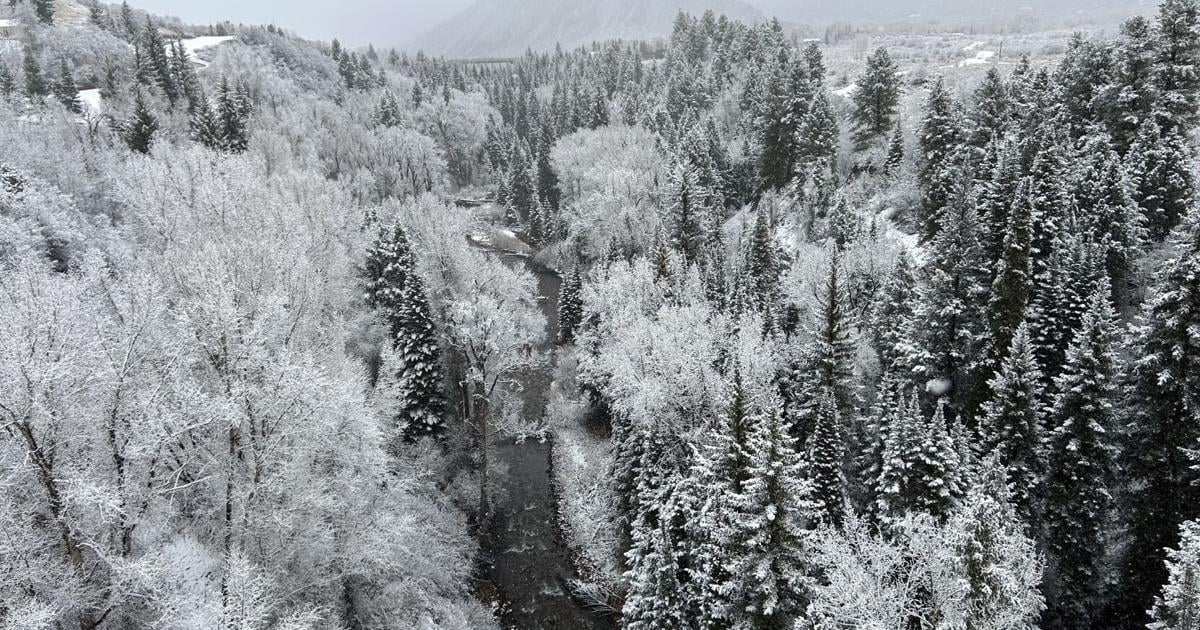Maroon Creek flows during a snowstorm on Monday. Stream flows in Maroon and Castle creeks, Aspen’s main water sources, are below average this year, prompting the city to enter into stage 2 water restrictions.
Rick Carroll/Aspen Daily News
The city of Aspen’s drought response committee is recommending the city maintain a stage 2 water shortage that was declared in August.
Monsoonal moisture and cooler temperatures that came since Aspen City Council activated the stage 2 restrictions have helped drought conditions, but not changed them, according to an information memo sent to city council this week. As of Nov. 6, Aspen and Pitkin County remained in severe and extreme drought categories, according to the U.S. Drought Monitor.
“Pitkin County has experienced its second driest year to date (January — September 2025) in 131 years of record with a precipitation deficit of 6.84 inches from normal,” the memo states.
Data collected from a National Weather Service station at the city’s water treatment facility recorded 1.52 inches of rain in August and 1.89 inches of rain in September. It brought the city’s precipitation deficit to 3.43 inches.
Water demand typically decreases in Aspen during the winter when irrigation systems are turned off, but it is when streams are at their lowest point in the year, according to the memo.
Councilman John Doyle, a staunch supporter of water conservation, said restrictions are especially important now as ski seasons get shorter and less snow falls.
“We did have a wet period, but it wasn’t enough to sustain us throughout this period. The moisture just hasn’t been there,” he said. “Any skier who’s paying attention knows that resorts across the west are struggling to open even with snowmaking systems … We had a very long, dry summer, we had a short wet spell, and we’ve had a very pleasant but dry fall up until today (Monday), very close to Thanksgiving.”
Ice cracks Nov. 11 on the Roaring Fork River, which is fed by Castle and Maroon creeks — the city of Aspen’s primary water sources. Aspen’s drought response committee is recommending the city maintain the stage 2 water shortage declared in August.
Jason Charme/Aspen Daily News
The stage 2 water shortage declaration came two months after the city declared a stage 1 water shortage with a goal to cut overall water consumption by 10% within city limits. Well below-average stream flows led the city to enact the second stage of water shortage, which represents severe drought conditions.
At the time, the monsoon season at the end of July was underwhelming and didn’t yield enough rain to improve drought conditions across the Western Slope.
The city relies primarily on streamflow from Castle and Maroon creeks for its water supply. It depends on consistent release of water from snowmelt.
The city’s stage 2 water restrictions are mandatory. Watering of any lawn, garden, landscaped area, tree, shrub or other plant is prohibited from 9 a.m. to 6 p.m. Household watering schedules are also mandatory.
Some of the city’s water customers are seeing monthly rate surcharges under the stage 2 restrictions. Tier three customers — those who use 10,000 to 14,000 gallons per ECU — see 50% surcharges under a stage 2 water shortage and tier four customers — those using over 14,000 per ECU — see a 75% surcharge.
Tier two customers in the Buttermilk Metro District see a 62.5% surcharge. There is a 50% surcharge for bulk water and fill stations, and pressurized and non pressurized water services.
In the winter, only about 1-3% of water customers fall into tiers three and four.
A stage 2 water shortage is designed to reduce system-wide water use by 10-15% and outdoor water use by 15-25%. The utilities department sent letters to the city’s top 10% of water users — about 300 users — notifying them of the new water restrictions. About half of the accounts remained in the top 10% of city water users by the end of September, according to the memo, but they still showed an average reduction in water use of 21%.
City facilities reduced water use by 5.6% under the stage 1 restrictions. Under the more stringent restrictions, city facilities saw a 30.4% reduction in water use.
The city last entered a stage 2 water shortage on Aug. 25, 2020. It lasted through June 6, 2023, when the city moved to stage 1 restrictions. Those restrictions were lifted on Sept. 24, 2024.

